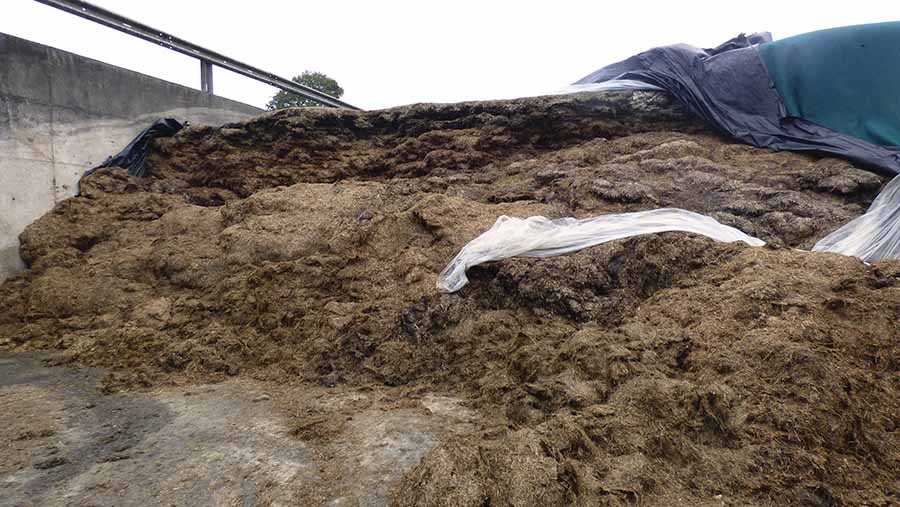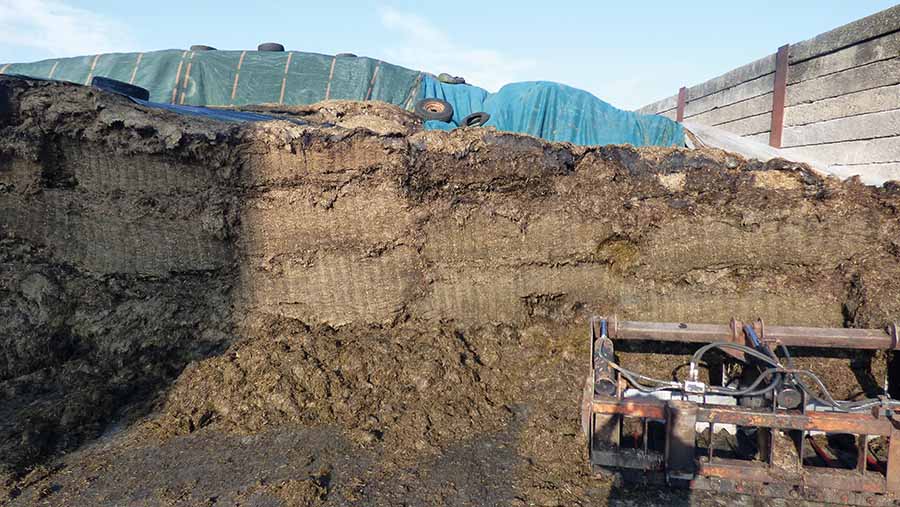What causes silage clamp slippage and how to avoid it
 © Dave Davies
© Dave Davies Uneven density is the biggest cause for silage slippage in UK clamps, an AHDB-funded study has concluded.
The 18-month study, which was conducted by independent consultant Dr Dave Davies of Silage Solutions, also found clamps were filled too steep on some farms and chop length was a tertiary contributing factor.
Silage slippage occurs when a vertical split appears in the clamp causing the front of the clamp to slip forward.
Dr Davies stressed clamp density was the main problem and urged farmers to ensure clamps were being filled and compacted appropriately ahead of first-cut silage.
See also: How multi-cut can deliver profits of £333/ha over three-cut silage systems
About the study
Farmers who had previously experienced slippage were asked to fill in a short survey.
Dr Davies then visited 10 beef and dairy farms throughout Scotland, England and Wales to examine what could have caused the problem.
- Visual assessments of the clamps were undertaken
- Core samples were taken from various points across the clamp
- Silage density was measured by dividing the weight from core samples by the volume of silage
- Particle size distribution was assessed using a modified particle separator developed at Harper Adams University on a previous AHDB-funded project
- And wet chemical analysis was carried out to determine nutritive values.
Results
- Silage quality was excellent overall. Neutral detergent fibre averaged 46% and crude protein averaged 16% across the 10 units, eight of which were dairy farms
- Average dry matter (DM) was 29%
- The average density across the clamps was more than 700kg of fresh matter per m cu. This is within the target of 700-750kg, however, density varied throughout the clamp on nearly all farms
- More than half of the farms had lower-density silage beneath higher-density, heavier silage, which created unstable structures
- Lower density silage was found to contain higher proportions of acetic acid compared to lactic acid created by air becoming trapped in the clamp. Acetic acid produces carbon dioxide and water. This increased the risk of “slip zones” when silage was cut out with a sheer grab, causing it to slip
- The filling angle on some pits was too steep (more than 20deg, which should never be exceeded)
- Chop length was too short in some instances (less than 30mm in silages with less than 25% DM)
- On average, there was a 10% difference in DM at different points in the clamp on almost all farms.
What the results mean
Historically, one of the key risk factors for silage slippage has been low DM silages, but Dr Davies said this was not the case in the study, with the average DM of silages at 29%.
“Silage was good quality. That means cow intakes are going to be good and you’re going to have a lower need for supplementation and produce more meat or milk from forage,” he added.
Dr Davies said clamp density was the greatest risk, causing half of all slips.
He likened this to having a structure like the “leaning tower of Pisa”, which creates a toppling effect.
He said it was therefore “critical” for farmers and contractors to check the pit was evenly well compacted each time more grass was added to the pit to prevent areas of instability.

© Dave Davies
How to avoid clamp slippage
- Be consistent when rolling the whole pit to avoid different densities across the clamp. For 30% dry matter (DM) silage roll in 15cm layers. For wetter silages (22%), roll in 25cm layers to avoid overworking it
- Some fields dry quicker than others so consider the order in which you mow and pick up fields. If you know some fields dry quicker, you could mow them later and pick them up sooner to avoid inconsistencies with DMs and aid more even compaction
- If you are filling and sealing the pit in one day, fill it at a 10-15deg angle
- If you are filling a pit over more than one day, consider filling it at a steeper angle (no more than 20deg) to protect the forage from spoilage and reduce the surface area
- <25% DM increase the chop length to 7.5cm to help stabilise the pit.
